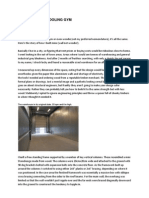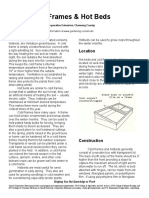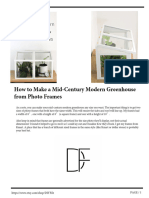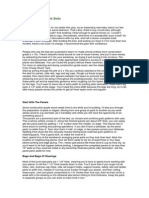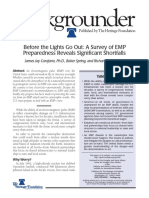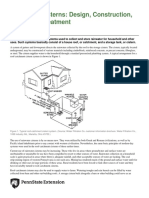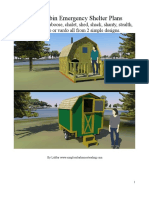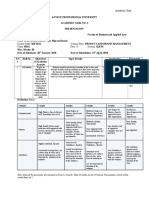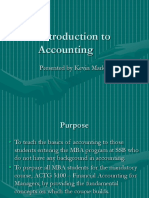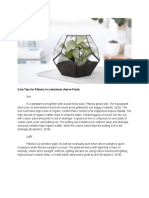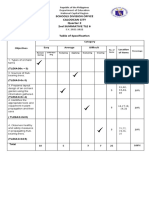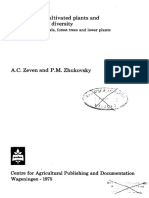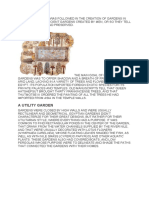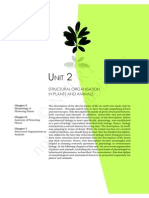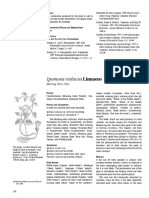1643 Vegetable Garden 1
1643 Vegetable Garden 1
Uploaded by
Arun SomanCopyright:
Available Formats
1643 Vegetable Garden 1
1643 Vegetable Garden 1
Uploaded by
Arun SomanOriginal Description:
Copyright
Available Formats
Share this document
Did you find this document useful?
Is this content inappropriate?
Copyright:
Available Formats
1643 Vegetable Garden 1
1643 Vegetable Garden 1
Uploaded by
Arun SomanCopyright:
Available Formats
Large Vegetable Garden Layout
24 x 24' Raised Bed Vegetable Garden
Vegetable Garden Layout
Diagrammed Sections
1 - 4 x 8 bed with sweet corn
2 - 4x8 bed with potatoes
3 - 2x8 bed with asparagus
4 - 4x4 bed with carrots
5 - 4x4 bed with parsnips
6 - 4x4 bed with cabbage and lettuce
7 - 4x4 bed with celery and onions
8 - 2x4 bed with radishes
9 - 4x8 foot bed with beans
10 - 4x8 foot bed with peas
Tools and Materials
Measuring tape
Stakes and string
96 feet of edging material
576 square feet of landscape fabric
576 square feet of gravel, 3-inches thick
Raised bed material
25 1-by-12-inch boards, 8 feet long for bed lumber
Approximately 15 bags of peat moss
Approximately 30 bags of planting soil
Approximately 30 bags of compost
Trellis material
4-foot rods or poles
Garden twine
Vegetable seeds or plants
Garden signs for each bed
Steps
1-Select a location for your garden.
The area needs to receive a minimum of 8 hours of direct sunlight each day, have good
drainage, and be near a water source for easy watering. The area should also be fairly level for
ease of construction. Measure out and mark a 24-by-24 foot square in the selected area. Mark
the square using stakes and string for a straight edge.
2-Install some form of edging to mark the garden.
Landscape timbers, bricks, stones, logs, cinder blocks, and short fences would all work well for
this purpose. Install the edging at least 3 inches high all the way around the garden area. The
stakes and string can now be removed.
3-Cover the inside area of the garden with landscape fabric.
Pin the fabric down with landscape pins. The fabric will kill the grass beneath it and help prevent
weeds from growing in your garden.
4-Cover the entire area with a 3-inch layer of gravel.
Pea gravel, drainage gravel, and crushed granite will all work fine. This gravel will help the
garden drain and provide walkways between the raised beds. The edging material should hold
the gravel inside the garden area.
5-Construct raised beds for the garden.
You will need four 4-by-4 foot beds, four 4-by-8 foot beds, and two 2-by-8 foot beds. Lumber is
the easiest construction method, see below for instructions on constructing these beds with
lumber. Arrange the beds inside the garden area as shown on the diagram. All beds should be a
minimum of 2 feet apart from the edge and each other for adequate walking room.
7-Spread a thin layer of peat moss in the bottom of each bed.
This will help with drainage. Fill the beds 3/4 of the way full with planting soil. Add compost to
the top of the beds and work it into the soil. Add extra compost to beds 1 and 2. Corn and
potatoes are heavy feeders and need lots of compost.
8-Build three pea trellis for bed number 10.
Make the trellis by tying long rods together at the top with garden twine (see diagram below)
and placing them in the garden bed. Rods can be made of wood, metal piping, PVC pipe, or
bamboo.
9-Mark each bed with garden signs.
Be sure to say what number the bed is and what is planted in it so you can keep track.
10-Plant each bed as follows:
1. Start sweet corn seeds indoors, and then transplant outside in late May or June. Plant
the corn seedlings directly into the compost, leaving 12 inches between each plant.
2. Plant potato starts directly into compost. Mid-March is the best time for planting.
3. Asparagus is a perennial vegetable. Plant 1-year-old crowns in the bed to start. Leave 1
foot between each plant, and plant 3 inches below the surface.
4. Sow carrot seeds thinly into the bed 1 inch below the surface. The best time for planting
is early March to the end of June.
5. Plant parsnips in March directly into bed. Sow seeds thinly 1 inch below the surface.
6. Buy a seed mixture package of cabbage and lettuce, or mix seeds yourself. Sow seeds
in March to July. The seed should be planted very thinly, 1/2 an inch below the surface.
7. Plant an alternating row of celery and onions. Use onion sets for easier planting, and
plant 4 inches apart. Sow celery directly into bed after last frost. Leave 8 inches between
plants.
8. Sow radishes in the spring after the last frost. Plant directly in the bed, 1/2 an inch below
surface.
9. Plant bush beans in this bed. Start with plants for best results. Plant one bean plant
every 1 foot in this bed.
10. Plant peas beside the trellis. Place two trellises in this bed. Plant one pea plant or seed
at each leg of the trellis, for six plants total. Plant in March for a early summer crop, or
July for a fall crop.
How to Build a Lumber Raised Bed
Use cedar lumber for best results and weather protection. You will need 25 1-by-12 foot boards
measuring 8 feet long.
Cut the following using a circular saw:
Leave 12 of the boards whole.
Cut 12 of the boards in half for 24 4-foot boards.
Cut the last board into four 2-foot lengths.
1. Arrange the boards on their sides according to the diagrams.
2. Screw them together with three 2-inch wood screws at each corner.
3. Make four 4-by-8-foot beds, four 4-by-4-foot beds, and four 2-by-8-foot beds.
Lumber Raised Bed Diagram
Trellis Diagram
You might also like
- Assignment Module 9Document20 pagesAssignment Module 9Sundas Usman79% (14)
- The Oil Palm 4th EditionDocument16 pagesThe Oil Palm 4th EditionAgus RasidNo ratings yet
- How To Tie Rebar - 15 Steps (With Pictures) - Wikihow PDFDocument4 pagesHow To Tie Rebar - 15 Steps (With Pictures) - Wikihow PDFa769No ratings yet
- Worm Harvester 212011Document0 pagesWorm Harvester 212011mattpac3No ratings yet
- British NationalDocument2 pagesBritish NationalDorelBuzneaNo ratings yet
- Spirit of Prophecy Fruit Tree Planting Technique 2 2Document2 pagesSpirit of Prophecy Fruit Tree Planting Technique 2 2api-265543512No ratings yet
- Environmental Control For Greenhouse TomatoesDocument8 pagesEnvironmental Control For Greenhouse TomatoesWyoming Native Plant Society100% (1)
- Growing Guide PeasDocument5 pagesGrowing Guide Peasharley100% (1)
- Bartok Geothermal Heat For GreenhousesDocument24 pagesBartok Geothermal Heat For GreenhousesAnonymous WNKDboSFl100% (1)
- Building Coldframes PDFDocument2 pagesBuilding Coldframes PDFykuijpers100% (1)
- Building A Dry Tooling GymDocument4 pagesBuilding A Dry Tooling GymCem BozkuşNo ratings yet
- Classic Entry BenchDocument5 pagesClassic Entry BenchO'Neil JonesNo ratings yet
- Horticulture Fact Sheets PDFDocument15 pagesHorticulture Fact Sheets PDFmasumbuko mussaNo ratings yet
- Heat Stress and Marijuana PlantsDocument12 pagesHeat Stress and Marijuana PlantsRoy HarperNo ratings yet
- Container Gardening LessonDocument11 pagesContainer Gardening LessonMikRaj Dilangalen GampongNo ratings yet
- Container Herb Gardening PDFDocument6 pagesContainer Herb Gardening PDFSudhakar JoshiNo ratings yet
- Cold Frames & Hot Beds: LocationDocument3 pagesCold Frames & Hot Beds: LocationykuijpersNo ratings yet
- Mini GreenhouseDocument9 pagesMini Greenhousegalatasaray-1995No ratings yet
- Bunk Beds: Start With The PanelsDocument5 pagesBunk Beds: Start With The PanelspoimandresNo ratings yet
- Tie BarsDocument18 pagesTie BarsKutty Mansoor100% (1)
- Eggplant Growing Agfact H8.1.29Document4 pagesEggplant Growing Agfact H8.1.29ronalit malintadNo ratings yet
- Microfiche Reference Library: A Project of Volunteers in AsiaDocument21 pagesMicrofiche Reference Library: A Project of Volunteers in AsialinteringNo ratings yet
- GreenHomeGuide FYIenergyauditDocument24 pagesGreenHomeGuide FYIenergyauditVinayak HegdeNo ratings yet
- Before The Lights Go Out: A Survey of EMP Preparedness Reveals Significant ShortfallsDocument15 pagesBefore The Lights Go Out: A Survey of EMP Preparedness Reveals Significant Shortfallss12originalNo ratings yet
- Methods of Groundwater ExplorationDocument13 pagesMethods of Groundwater Explorationonyinyechimaureen785No ratings yet
- Raising Poultry AnimalsDocument26 pagesRaising Poultry AnimalsEloisa CaragNo ratings yet
- Impact of Menopause Symptoms On Women in The WorkplaceDocument13 pagesImpact of Menopause Symptoms On Women in The WorkplaceMarcos Pitta TerraNo ratings yet
- Visit For More DIY ProjectsDocument13 pagesVisit For More DIY ProjectsCarlos puentesNo ratings yet
- Workshop Assignment: By: Sneha Motghare Div: B Roll No:26 Batch:2 Taught By: Vilas SirDocument15 pagesWorkshop Assignment: By: Sneha Motghare Div: B Roll No:26 Batch:2 Taught By: Vilas SirVinay MotghareNo ratings yet
- Build A Closet Organizer: Tools Checklist Materials ChecklistDocument2 pagesBuild A Closet Organizer: Tools Checklist Materials ChecklistDobrica IlicNo ratings yet
- Patrol Box PlansDocument10 pagesPatrol Box PlansAlessandro UrendaNo ratings yet
- Beginners Guide To Septic SystemsDocument4 pagesBeginners Guide To Septic SystemsBob CNo ratings yet
- How To Plan A Square Foot GardenDocument2 pagesHow To Plan A Square Foot GardenEZGarden100% (1)
- Earthbag Building: Spiral 2 House PlanDocument7 pagesEarthbag Building: Spiral 2 House Planlighteagles131No ratings yet
- Wicking Bed Gardening: A Water Wise Solution To Growing Your Own VegetablesDocument2 pagesWicking Bed Gardening: A Water Wise Solution To Growing Your Own VegetablesDrought Gardening - Wicking Garden BedsNo ratings yet
- Plant Propagation of Woody OrnamentalsDocument6 pagesPlant Propagation of Woody OrnamentalsDisenyo ArkitektoNo ratings yet
- Planting Apple TreesDocument2 pagesPlanting Apple TreesAPRIL RHOSE ALBITONo ratings yet
- Barbecue Tool Cabinet: Click Here To Download Detailed InstructionsDocument3 pagesBarbecue Tool Cabinet: Click Here To Download Detailed Instructionsmytizplicky100% (1)
- Food Dehydration For Beginners - A Step-By-Step Guide With Delicious RecipesDocument58 pagesFood Dehydration For Beginners - A Step-By-Step Guide With Delicious RecipesgerolamocarilluzzoNo ratings yet
- GE6162-Engineering Practices Laboratory PDFDocument167 pagesGE6162-Engineering Practices Laboratory PDFBala ChandarNo ratings yet
- Rainwater Cisterns: Design, Construction, and Water TreatmentDocument17 pagesRainwater Cisterns: Design, Construction, and Water Treatmentapi-331623679No ratings yet
- Making and Using A Solar Cooker... by Joe RadabaughDocument4 pagesMaking and Using A Solar Cooker... by Joe RadabaughBLINDED185231100% (2)
- Potatoes - Organic Growing Guides For Teachers + Students + SchoolsDocument1 pagePotatoes - Organic Growing Guides For Teachers + Students + SchoolsOrganic Growing Guides - One Pot PledgeNo ratings yet
- Final Synopsis PHDDocument12 pagesFinal Synopsis PHDshailaNo ratings yet
- A Guide For The Septic System OwnerDocument19 pagesA Guide For The Septic System OwnerhuyvuNo ratings yet
- Bow Top Conestoga Gypsy Vardo: InstructablesDocument28 pagesBow Top Conestoga Gypsy Vardo: InstructablesRod HyattNo ratings yet
- Free Vegetable Planting GuideDocument1 pageFree Vegetable Planting GuidebcyboronNo ratings yet
- Building A Water WheelDocument5 pagesBuilding A Water WheelMANNAJANELAGUNA100% (1)
- WheelbarrowDocument2 pagesWheelbarrowsavergirl69No ratings yet
- Arbor - Lath Arch Rose ArborDocument6 pagesArbor - Lath Arch Rose ArborDaniel LourençoNo ratings yet
- Menopause: Treatments For Menopausal SymptomsDocument9 pagesMenopause: Treatments For Menopausal SymptomsAmy LalringhluaniNo ratings yet
- Science: Hoop House Construction For New MexicoDocument10 pagesScience: Hoop House Construction For New MexicoWen RollandNo ratings yet
- Hydroponic Herb GardenDocument3 pagesHydroponic Herb GardenAbdul RazakNo ratings yet
- Making An Undershoot Water WheelDocument6 pagesMaking An Undershoot Water Wheelkundra007No ratings yet
- Perma (Permanent) Culture: The Prime Directive of PermacultureDocument13 pagesPerma (Permanent) Culture: The Prime Directive of Permaculturebulut83No ratings yet
- Mirocabin Plans FinishedDocument39 pagesMirocabin Plans FinishedJeffrey Witty100% (1)
- The Floating Arm TrebuchetDocument9 pagesThe Floating Arm Trebuchetmarandan85No ratings yet
- Zombie Apocalypse ProjectDocument26 pagesZombie Apocalypse Projectapi-463607341No ratings yet
- W O C F G: NtroductionDocument11 pagesW O C F G: NtroductionEduardo Luiz Schilling100% (1)
- Installing a Garage Door and Opener- Special Bundle: Cake Decorating for BeginnersFrom EverandInstalling a Garage Door and Opener- Special Bundle: Cake Decorating for BeginnersNo ratings yet
- 00237Document4 pages00237Arun SomanNo ratings yet
- 00222Document2 pages00222Arun SomanNo ratings yet
- Synthesis and Application of Granular Activated Carbon From Biomass Waste Materials For Water TreatmentDocument27 pagesSynthesis and Application of Granular Activated Carbon From Biomass Waste Materials For Water TreatmentArun SomanNo ratings yet
- Procter & Gamble Vs Unilever: A Case of Corporate EspionageDocument9 pagesProcter & Gamble Vs Unilever: A Case of Corporate EspionageArun SomanNo ratings yet
- Suggestive Topics in Human Resource ManagementDocument12 pagesSuggestive Topics in Human Resource ManagementArun SomanNo ratings yet
- Lotus Herbals: Manufacturer of Moisturizers, Lemon Pure EtcDocument11 pagesLotus Herbals: Manufacturer of Moisturizers, Lemon Pure EtcArun SomanNo ratings yet
- 00238Document1 page00238Arun SomanNo ratings yet
- A1354512403 22664 21 2018 Individualpresentation622Document2 pagesA1354512403 22664 21 2018 Individualpresentation622Arun SomanNo ratings yet
- Finance Functions/ Classification of Financial DecisionsDocument10 pagesFinance Functions/ Classification of Financial DecisionsArun SomanNo ratings yet
- ArunsomanDocument1 pageArunsomanArun SomanNo ratings yet
- 1 - MBA 1st Yr GD and PI Schedule On 18th Nov 17Document54 pages1 - MBA 1st Yr GD and PI Schedule On 18th Nov 17Arun SomanNo ratings yet
- RP Tip Print NewDocument14 pagesRP Tip Print NewArun SomanNo ratings yet
- HDFCDocument1 pageHDFCArun SomanNo ratings yet
- A1825371902 - 21538 - 16 - 2017 - Format - MBA With Live ProjectDocument1 pageA1825371902 - 21538 - 16 - 2017 - Format - MBA With Live ProjectArun SomanNo ratings yet
- Unit 1 McqsDocument5 pagesUnit 1 McqsArun Soman0% (4)
- An Introduction To Basic Macroeconomics Concepts: (Synopsis/Summary)Document1 pageAn Introduction To Basic Macroeconomics Concepts: (Synopsis/Summary)Arun SomanNo ratings yet
- 1 - Annual Athetic Meet SheduleDocument7 pages1 - Annual Athetic Meet SheduleArun SomanNo ratings yet
- Curriculum Vitae 1Document1 pageCurriculum Vitae 1Arun SomanNo ratings yet
- Name: Contact Info:: Place: Jalandhar DateDocument1 pageName: Contact Info:: Place: Jalandhar DateArun SomanNo ratings yet
- The Determination of Exchange RatesDocument41 pagesThe Determination of Exchange RatesArun SomanNo ratings yet
- A924635910 - 17775 - 18 - 2017 - Assignment 2 MGN514Document5 pagesA924635910 - 17775 - 18 - 2017 - Assignment 2 MGN514Arun SomanNo ratings yet
- ABC LTD Company: Month Sales January 100 Feb 99 March 88 April 77 May 66 June 55 July 44 August 33 Total 562Document4 pagesABC LTD Company: Month Sales January 100 Feb 99 March 88 April 77 May 66 June 55 July 44 August 33 Total 562Arun SomanNo ratings yet
- Introduction To Accounting - UnknownDocument159 pagesIntroduction To Accounting - UnknownArun Soman100% (1)
- AngiospermDocument14 pagesAngiospermJoy EscamillasNo ratings yet
- CitrusDocument100 pagesCitrusDac100% (1)
- Plant HormonesDocument34 pagesPlant HormonesSimamkeleNo ratings yet
- Department of Education: Republic of The PhilippinesDocument3 pagesDepartment of Education: Republic of The PhilippinesJari Cruz100% (1)
- Fittonia Care TipDocument5 pagesFittonia Care TipAcross CodingNo ratings yet
- Sifat-Sifat Allah - 20231103 - 150233 - 0000Document1 pageSifat-Sifat Allah - 20231103 - 150233 - 0000aliza.saputroNo ratings yet
- Clima - Yasmin Ruth - M - Crsci 1100 Exercise No.2Document3 pagesClima - Yasmin Ruth - M - Crsci 1100 Exercise No.2Yasmin Ruth ClimaNo ratings yet
- Initial Survey Report of Nursery BusinessDocument5 pagesInitial Survey Report of Nursery BusinessAsad Asad100% (2)
- OatsDocument11 pagesOatssusmita dasNo ratings yet
- Biology 3rd QTR Activities 1Document7 pagesBiology 3rd QTR Activities 1Mark Laurence MasellonesNo ratings yet
- Maize Training Manual For Extension Workers in UgandaDocument75 pagesMaize Training Manual For Extension Workers in UgandaNGANJANI WALTERNo ratings yet
- Pest and Disease Management in Horticulture Crops-1Document171 pagesPest and Disease Management in Horticulture Crops-1SHADOW GAMINGNo ratings yet
- Bengaluru - Citizenmatters - in - How To Make Mini Forest Miyawaki Method 34867 PDFDocument9 pagesBengaluru - Citizenmatters - in - How To Make Mini Forest Miyawaki Method 34867 PDFDebi GhoshNo ratings yet
- 2ND-2nd QRTR - SUMMATIVE-TEST in Tle 6Document3 pages2ND-2nd QRTR - SUMMATIVE-TEST in Tle 6MarilynPajonillanTagnepis100% (1)
- Toxicity Test and Allelopathy Test of Alang-Alang (Imperata Cylindrica) EXTRACT ON RICE SEED (Oryza Sativa)Document9 pagesToxicity Test and Allelopathy Test of Alang-Alang (Imperata Cylindrica) EXTRACT ON RICE SEED (Oryza Sativa)Andrian ZakyNo ratings yet
- Nutritional Benefits of AvocadosDocument2 pagesNutritional Benefits of AvocadosIndra SetiawanNo ratings yet
- Ultimate Indoor Garden PDFDocument3 pagesUltimate Indoor Garden PDFAnonymous iFOsKJ0% (1)
- Dictionary Cultivated PlantsDocument217 pagesDictionary Cultivated PlantsJorgeNo ratings yet
- Protists, Fungi, and Plants Notes - 6th GradeDocument10 pagesProtists, Fungi, and Plants Notes - 6th GradeAlyssaNo ratings yet
- Egyptian GardenDocument12 pagesEgyptian Gardendaisy baronNo ratings yet
- © Ncert Not To Be Published: Structural Organisation in Plants and AnimalsDocument21 pages© Ncert Not To Be Published: Structural Organisation in Plants and AnimalsVijay VallipiNo ratings yet
- Optimization of Alocasia Amazonica ProliferationDocument8 pagesOptimization of Alocasia Amazonica ProliferationRobertFWainblatIIINo ratings yet
- Ipomoea (Christian Rätsch, Encyclopedia of Psychoactive Plants)Document8 pagesIpomoea (Christian Rätsch, Encyclopedia of Psychoactive Plants)Antonio TorízNo ratings yet
- DR Manoj Joshi Department of Botany Khandelwal College of Management Science and TechnologyDocument19 pagesDR Manoj Joshi Department of Botany Khandelwal College of Management Science and Technologykhanzubair8867No ratings yet
- Voter List For Election 2018 - 2019Document112 pagesVoter List For Election 2018 - 2019Pooja kumariNo ratings yet
- NZ Blueberry Nutrition Programme 2018Document1 pageNZ Blueberry Nutrition Programme 2018Kevin Eduardo ChipugsiNo ratings yet
- Pteridophyta TableDocument1 pagePteridophyta TableA-0315-12 PRASHARADHA S KUMARNo ratings yet
- Grafting and Budding Nursery Crop PlantsDocument20 pagesGrafting and Budding Nursery Crop PlantsArt Del R SalongaNo ratings yet










